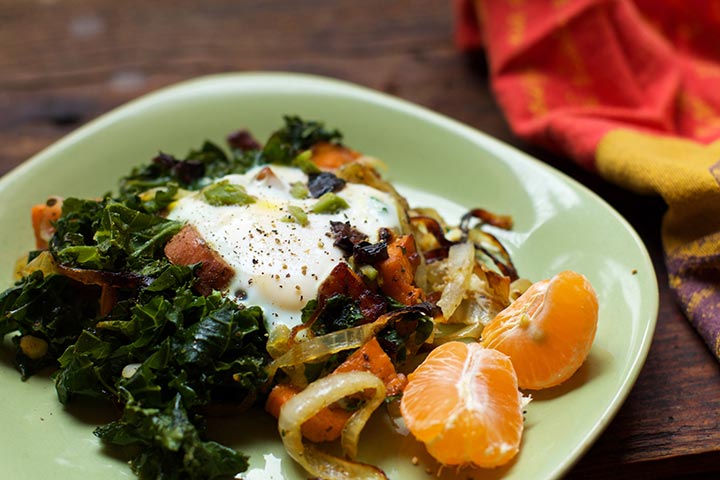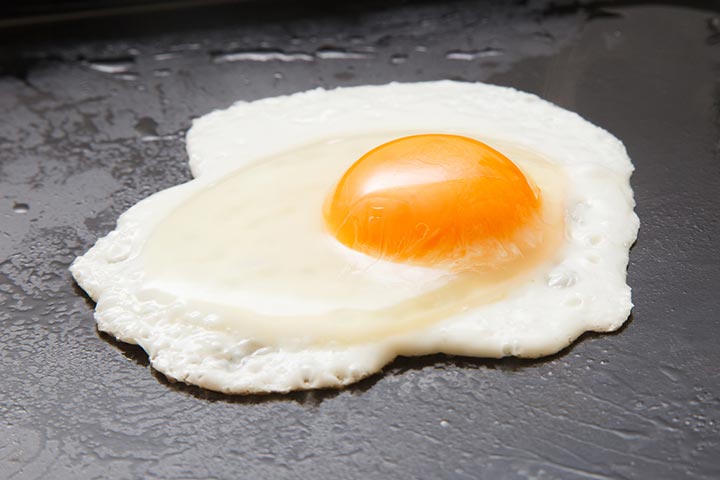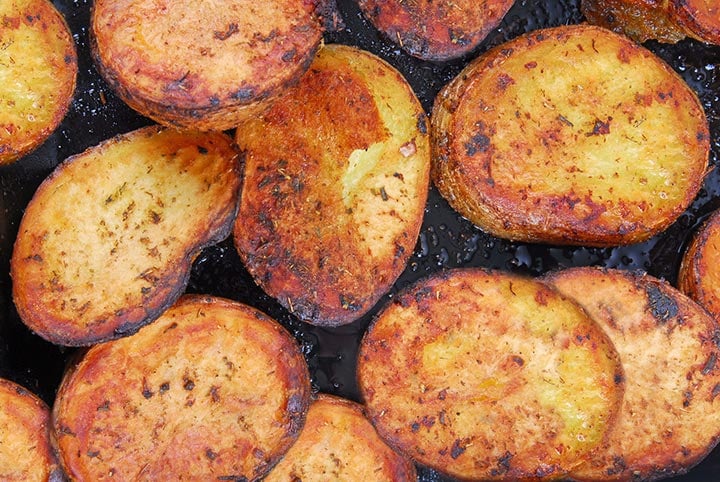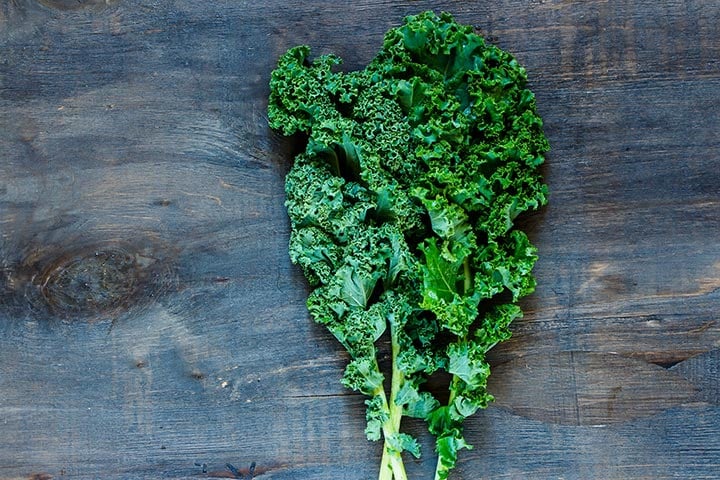My husband and I have this little game we play; it’s called “How many sources of phytonutrients are in this meal?”
I promise it’s more fun than it sounds.
We started this game after seeing a lecture by herbalist Dr. Kevin Spelman on the importance of eating lots of different plants in our daily diets. In this lecture, he talks about how the diversity of plants in our diet positively impacts our genes (epigenetics) and how humans have coevolved with plants so that our bodies are coded to recognize this wide variety of nutrients.
You’ve probably heard that our pre-agricultural ancestors most likely ate hundreds more species of plants than we currently do. Dr. Spelman hypothesizes that our rise in chronic illnesses is being caused by this lack of plant diversity within our diets. He says:
“Chronic disease may come from a lack of phytochemical exposure. Your ancestors had 8-10 times (a conservative estimate, probably more realistic estimate is maybe a hundred times more) exposure to phytochemistry than we do today. And that [lack of exposure] foments chronic disease.”1
In fact, the average US diet is pretty dismal when it comes to plants, both in quantity and diversity.
An NPR article reports:
Americans eat 1.5 cups of vegetables daily, on average, the USDA finds. But the national nutrition guidelines recommend 2 to 3 cups a day for adults. And more than half our veggie intake comes from potatoes and tomatoes, whereas only 10 percent comes from dark green and orange veggies like spinach, carrots and sweet potatoes.2
See…pretty dismal!
Not only does this mean that most people are not getting the micronutrients they need, they also are lacking in phytonutrients. Both are important, but today’s article is going to focus on phytonutrients.
First let’s back up a bit. What are phytonutrients and micronutrients? Micronutrients is a fancy word for vitamins and minerals. For example, Vitamins A, B, C, and D, magnesium and calcium are micronutrients.
As we saw above, the current national nutrition guidelines recommend 2-3 cups of fruits and vegetables a day in order to get an adequate amount of micronutrients. (I consider this to be on the low side myself, but it’s pretty telling that most people aren’t even getting this small amount!)
What are phytonutrients? Sometimes called phytochemicals, these the natural chemicals found in plants. While we could quickly list all the micronutrients, there are over 10,000 known phytonutrients and probably just as many we don’t yet know about.
When thinking about micronutrients, we need to think about getting enough of one food to give us adequate amounts of each nutrient. For example, we know that taking a bite of a carrot isn’t going to do a lot for our health, but getting a cup of carrots regularly will likely provide enough beta carotene to our diet.
When thinking about getting enough phytonutrients in our diet, it’s less about getting enough of one plant and more about getting a little bit of a wide diversity of plants.
Dr. Kevin Spelman says he doubts that even herbalists get as many as 10 sources of phytonutrients per day. I hope he’s wrong, but I fear he’s right.
Take a moment and count how many different plants you generally consume in a day. Do you get over ten? However many you regularly get, I hope this article will help inspire you to get even more. Spelman says our ancestors got anywhere from 80-200 different types of plants in their diets, and while some of us may be getting more than 10, I am sure many of us fall short of the diversity that was seen in our ancestral diets.
How to Get More Phytonutrients in Your Daily Diet
Let’s look at a standard healthy breakfast recipe:
1 egg, potatoes, kale
This is considered a healthy meal (and one could easily argue, much healthier than most people in the U.S. are eating for breakfast).
Using a couple of different sources, I looked up the nutritional data for these three foods. Here’s a quick look. (No need to memorize this, you’ll see the point I am going to make in just a moment). 3 4
Dietary Fiber, Protein, Thiamin, Riboflavin, Folate, Iron, Magnesium and Phosphorus, Vitamin A, Vitamin C, Vitamin K, Vitamin B6, Calcium, Potassium, Copper and Manganese, beta-carotene, lutein, zeaxanthin retinol, Protein, Riboflavin, Vitamin B12 and Phosphorus, Selenium, Saturated Fat Cholesterol, Vitamin C, Vitamin B6, Potassium and Manganese.
But while this breakfast may be “healthy” it could be spiced up with a lot more diversity and phytonutrients and that’s exactly what today’s recipe is all about.
To show you a crude visual representation of the difference some herbs and spices can make, I looked up the phytonutrients for the same general breakfast, but with the addition of some herbs and spices (recipe below).
I think you’ll see what I mean when a little bit of diversity can go a long way. 5
6 7 8
Dietary Fiber, Protein, Thiamin, Riboflavin, Folate, Iron, Magnesium and Phosphorus, Vitamin A, Vitamin C, Vitamin K, Vitamin B6, Calcium, Potassium, Copper, Manganese, beta-carotene, lutein, zeaxanthin retinol Protein, Riboflavin, Vitamin B12, Phosphorus, Selenium, Saturated Fat Cholesterol, dietary Fiber, Vitamin B6, Potassium, Vitamin A, Vitamin C and Manganese, diallyl sulphate, alliin, ajoene, allicin, tannic acid, borneol, iso-bornyl acetate, carnosol, cineole, pinene and camphor, linalool, rosmanol, terpeniol and verbinol., rosmarinic acid, flavonoids, limonene, tyrosol, hydroxytyrosol, oleuropein, ligstroside, apigenin, luteolin, caffeic acid, cinnamic acid, ferulic acid, coumaric acid, cyanidins, peonidins, rutin, vanillic acid, syringic acid, cepaenes, thiosulfinates, quercetin, kaempferol, borneol, cymol, apigenin, luteolin, saponins, triterpenic acids, vitamin C, biotin, molybdenum, vitamin K, copper, potassium, manganese, dietary fiber, beta-carotene, vitamin B6, folate, niacin, vitamin E, and phosphorus, esculeoside A, chalconaringenin, naringenin, chalconaringenin, rutin, kaempferol, quercetin caffeic acid, ferulic acid, coumaric acid, lycopene, lutein, zeaxanthin, beta-carotene, camphene, eugenol, carvone, phellandrene, myristicin, pinene, limonene, piperine, chavicine.
Please keep in mind these are crude lists of nutrients just to make this point: adding a diversity of herbs and spices to your meal greatly enhances your sources of phytonutrients.
I wasn’t kidding when I said my husband and I add up the sources of phytonutrients in our meals. But I hope that challenging yourself to diversify your diet isn’t really about counting anything, but instead is more about creating delicious and complex tasting food.
Let’s take this healthy breakfast recipe as an example of a great way to start the day.
Healthy Breakfast Recipe: Sweet Potatoes, Kale and Eggs
This healthy breakfast recipe takes healthy ingredients often found on a breakfast plate and spices it up to include a lot more plants. This makes a great weekend brunch when time isn’t an issue. If you’re pressed for time, make the potatoes, onions, garlic and kale the night before.
What you’ll need…
- 2 tablespoons olive oil
- 1/2 of an onion, sliced
- 3 garlic cloves, minced
- 1 medium sweet potato, cut into 1/4 inch rounds then cubed
- 1 teaspoon thyme
- 1 teaspoon rosemary
- 1/2 teaspoon salt
- 3-5 leaves of kale, chopped well
- 2-4 farm fresh eggs
- 1 tablespoon minced olives
- 2 tablespoons minced sun dried tomatoes (for convenience, buy these in a jar)
- black pepper
Preheat oven to 350°F.
Place 1 tablespoon of olive in an oven-safe pan with a lid (I used a cast iron pan with a cookie sheet as a lid). Add the onions and garlic, stir well to coat the onions with oil.
In a small bowl place 1 tablespoon olive oil, the cubed potatoes, thyme, rosemary and salt. Stir well to coat. Add this to the oven-safe pan, leaving the onions on the bottom of the pan (otherwise they may burn).
Bake, uncovered, for 30 minutes or until the potatoes are cooked through.
Add the chopped kale. Stir well. Continue to bake uncovered for 5 minutes or until the kale is gently wilted.
Add the cracked eggs individually to the pan. Top with the olives and tomatoes. Lightly salt the eggs.
Cook, covered, for an additional 7-8 minutes or until the eggs are cooked to your preference.
Remove from the oven and lightly dust with freshly ground pepper. Serve immediately.
Depending on eggs served or how hungry you are this makes 2-4 servings.
I hope you enjoy this healthy breakfast recipe but, more than that, I hope you incorporate the concept of getting more phytonutrients in your daily diet. Maybe you’ll mimic our family’s game of counting how many phytonutrient sources are in each meal. For this breakfast recipe, I count ten different types of plants. Add a cup of tea or coffee and you’ve got 11. Add artichokes to the dish: 12. Serve with a side of fruit: 13. And on and on.
How much is enough? I’m sure there’s no upper limit. We aim for 10 different plants per meal – sometimes we do more, sometimes we fall short – but since we attended the Kevin Spelman lecture, we certainly get more than we used to.
I’ll leave you with another quote from Dr. Spelman:
DOWNLOAD NOW“Stop and think about this today when you eat. You are going to consume something rich in phytochemicals (I hope). You are going to steep your genes in that and you do that daily. If you think of that phytochemistry as information, what kind of message are you carrying in your body? What kind of message are you delivering to your genes?”


















This is excellent information Rosalee! Great way to look at things. I’ve been wanting to get some ideas on how to incorporate more plant based foods in my diet. without having to eat a salad every day or twice a day. Thanks for this posting!
I love this and have made my own variation from time to time. Its especially good because I don’t eat cereals or bread and really like starting off my day with something nourishing and protein I love the flavours of this too and you can do so many variations depending on which veggies you use. I often cook extra veggies so I can do this in the morning quickly.
This looks absolutely delicious, definitely a breakfast upgrade for sure! Thanks for such detailed instructions, I’ll definitely be making this :)
I try, but it is nowhere near ten, lol! This week I tried a new vegetable – rapini. I rotate through types of greens (dandelion, chard, kale, beet, rapini, etc.) based on what is in season. I try to add beet roots, parsnips, sweet potatoes in the winter and then the cabbage family buddies, brussels sprouts and cabbage (red and green). I no longer eat ‘breakfast’ foods always at breakfast and it is likely to be onions and vegetables along with my eggs or sometimes even without the eggs.
Today’s breakfast was:
Egg, red and yellow sweet peppers, rapini, onions, garlic, one piece of bacon and a slice of muenster cheese with half a piece of Eureka bread.
I don’t know of Spelman, but I think there was less variety 100 years ago than is laid out here. I do think in season and fresh is critical, and eating from different color groups. I’ll have to look his information up, thanks!
Great educational article and recipe, Rosalee! Since I’m allergic to eggs, what would you suggest as a replacement in this recipe?
Also, I just want to thank you for all the wonderful info you continually contribute to this site. You are a treasure!
I would substitute raw nuts either eaten as is or soaked overnight and added to the recipe. Soaking nuts overnight makes them easier to digest.
Thanks, Marlene, that’s a great idea… and I love nuts!
If I couldn’t eat eggs I would eat chicken or another source of protein. You could also do a side of Greek yogurt with fruit. So many possibilities. One way I like to judge a breakfast is how long it fills you up. I see a lot of folks in my practice who grab a bagel out the door and then crash a couple hours later and then eat a muffin (or something similar) as a pick me up. What I like about this nutrient dense breakfast is that I am satisfied for about four hours. This means there isn’t a blood sugar spike and crash that people typically get with a carb only breakfast.
I’m excited about starting Rosalee, I’m not going to lie. Getting excited is an excellent way to get started. Just because I’m a nurse and a herbalist doesn’t mean I eat well. Yes I’m one of those people and a great target audience. Picture and recipe look enticing and your list of micronutrients compelling. You and your husband’s game is a smart one and I must be a geek because it looks like a fun one too! Having fun is a great way to make life changes that last and a great tool for learning so thanks for the motivation cause girl I need all the help I can get for all the above. Your the Best Rosalee!
I will be out buying more spices today and my dried lamb’s quarters will be used more often. I knew the wild plants are higher in nutrients but forget to incorporate it with my meals. The reminder was good for me. Thank you for the recipe.
Hi! Great information, as always! I have a question: For dietary reasons I should not eat sweet potatoes (or potatoes, for that matter). Can you suggest a somewhat equal substitute?
I would make a stir fry of veggies you can have. Cabbage, winter squash, bok choy, broccoli, spinach, etc.
Don’t forget to sprinkle dulse powder or flakes on your food or in your soup, or make a nori wrap out of it!
I often make versions of this, but I love it that this recipe is baked in the oven! One way I add a variety of veggies to each meal is to include a serving of home-made fermented veggies; kimchi or kraut, made with many different vegetables and seaweeds.
Sounds delicious! What if I add different bell peppers (all different colors) and mushrooms?
Sounds great!
Thank you all for the great ideas encouragement and support in helping to widen our minds heart and lives to healther living.
I came grime a very in health background in food & lifstyle .
But am doing so much better still going on the journal to good health and life but thanks for what you do.
Used to be around 400 lb. Now about 230 lb. Was uncontrolled diabetes blood pressure colestoral and others.
Great article, thank you! Is there a cookbook or resource that you can recommend that has ample healthful breakfast recipes? I always find that good breakfast recipes are few, and I’d really like to step up our morning meals.
I don’t know of one Victoria. I have lots of cookbooks, but none of them are breakfast centered.
For breakfast I had an apple with peanut butter and pecan butter. Lunch was potatoes, rice, red cabbage with cumin, black pepper and garlic. Plus the three cups of herbal tea today, I am at ten or better. Keep helping me think, I like it!
Such a Superb recipe!!! Here in Pa.I picked dandelions last month! I had a stomach bug last night,so for breakfast I only had saltines & water! Then later I had bone broth & now I’m having bone broth & a smoothie I made last night,that has many varieties of greens! I wanted to ask U with the different color peppers could you use the seeds inside? Would they have any benefit? After all;we’ve been taught to clean the seeds out!
You have so much wisdom,I figured I’d ask you!!!
Thanks,Sue Wesley
Every night I eat an organic rainbow. I start the sauté with onion, add beet, purple carrot, daikon, sweet potato or winter squash, then 1 or 2 greens from kale, collard, beet greens, arugula, spinach, then the garlic and zucchini. I’m partial to spicing this with coriander and 1 or 2 herbs like thyme, basil, or marjoram. Then I top the veggie nest with a protein like wild caught pink salmon or organic chicken I’ve cooked in apricot/apple nectar sprinkled with cranberries. It’s SO beautiful and fun to make art with my food. I make a large batch on the weekend so I can have this great food after work.
Dear Carol,such a good portrayal: an organic rainbow,with all the top nutrients in it!!! Thank-U!
Add a little bit of ginger and chili an there u go
As a herbivore, I would use millet or quinoa in place of the egg.
Love this breakfast! Will be making soon. One question. Is the above recipe with dried or fresh herbs? Does it make a difference in the phytonutrients if the herb is dried or fresh?
Winters are long here and we eat a LOT of dried herbs and vegetables.
The above recipe used dried rosemary and thyme. These herbs store really well. Everything else was fresh. Some plants quickly lose their nutrients when dried and others don’t. If you’re interested in learning about this further I recommending the book: Eating on the Wild Side by Jo Robinson.
You are the coolest lady,and I love all the recipes and information u share with us. I feed my dog baked sweet potatoes in a base of chicken carrots and green beans kale broccoli spinach dandilion greens topped with raw meat balls,all organic of course. I put algae based DHA ,spirulina,coconut oil and chia seeds along with probiotics and enzymes in every breakfast for the past 7 months. He is now cancer free and thriving! I will continue to feed him this forever as I am thoroughly convinced that u CAN change your health thru your diet. Now if I could only eat as good as he does!! Thank u for sharing?
I make a form of this but i was always wondering if i was going overboard with all the extra herbs i put in my food. whenever i make a savory meal, besides cooking always with either onions garlic or both, i add lots of dried herbs before eating like dry powdered nettle, bears garlic, seaweed, and nutritional yeast. Sometimes even more. i also add fermented foods and drinks before, during, or after. I guess my question is, there such thing as too much variation in a meal?
I don’t think so. As long as it tastes good anyway. :) We often eat Indian inspired meals because they literally have handfuls of many different spices in each dish. I really think there is something to that!
Thanks for appetizing breakfast recipy and the possibility to download it.
I have a lot of wild berries in the freezer as well as vegetables from my brother’s own plot of land. Berries are used for morning smoothies in different combinations with nuts, seeds and coconut oil.
In autumn we usually make fermented saurkraft and apple vinegar.
The only thing is to be learned and practiced and that is how to use spices properly and in appropriate combinations. Live and learn!
Great info and useful healthy recipe. Thank you for the details! I am currently in the beginning stages of studying nutrient therapy. I would love to learn even more about phytonutrients. Can you suggest particularly useful up-to-date references to learn more about this topic (including materials on what phytonutrients are in particular foods)? Thank you!
Hi Juliane B,
The study of phytonutrients is essentially herbalism! While most traditionally trained herbalists prefer to use/recommend whole plants as opposed to isolated chemicals, some herbal programs are focused on individual plant chemistry. Besides the many herbals out there in the world I can think of one book that may be of interest to you. One is “Eating on the Wild Side” by Jo Robinson. If you do a search for that author there’s also been some good interviews with her.
Instead of salt, I am using kelp and dulse granules/dulse powder. It adds another flavor too. Trying to get more greens in; some is better than none!
Hi, I’m wondering about phytonutrients in canned or bottled foods like olives and sun dried tomatoes? When these foods are in cans or jars that have been heated are they “dead” or severely damaged?
Hi Rosalee,
Thank you so much for sharing. I am just beginning this new lifestyle of eating clean. I love that you’re made a game out of it. I will share this with my 14 year old son. I am excited to add what I’very learn on your post. Thank you again!